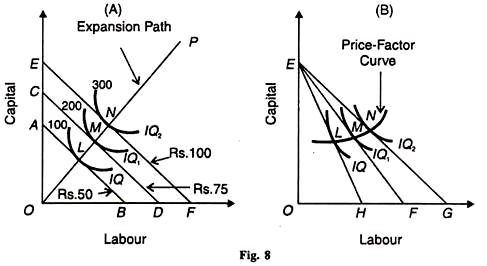The below mentioned article provides short notes on Iso-Cost Curves and Expansion Path.
Having studied the nature of isoquants which represent the output possibilities of a firm from a given combination of two inputs, we pass on to the prices of the inputs as represented on the isoquant map by the iso-cost curves.
These curves are also known as outlay lines, price lines, input-price lines, factor-cost lines, constant-outlay lines, etc. Each iso-cost curve represents the different combinations of two inputs that a firm can buy for a given sum of money at the given price of each input.
Figure, 8 (A) shows three iso-cost curves AB, CD and EF, each represents a total outlay of 50, 75 and 100 respectively. The firm can hire ОС of capital or OD of labour with Rs.75. ОС is 2/3 of OD which means that the price of a unit of labour is 1 ½ times less than that of a unit of capital. The line CD represents the price ratio of capital and labour.
ADVERTISEMENTS:
Prices of factors remaining the same, if the total outlay is raised the iso-cost curve will shift upward to the right as EF parallel to CD, and if the total outlay is reduced it will shift downwards to the left as AB. The iso-costs are straight lines because factor prices remain the same whatever the outlay of the firm on the two factors. The iso-cost curves represent the locus of all combinations of the two input factors which result in the same total cost.
If the unit cost of labour (L) is w and the unit cost of capital (C) is r, then the total cost:
TC = wL + rC. The slope of the iso-cost line is the ratio of prices of labour and capital i e w/r. or PL/РС where P is price.
ADVERTISEMENTS:
Expansion Path:
The point where the iso-cost line is tangent to an isoquant represents the least cost combination of the two factors for producing a given output. If all points of tangency like LMN are joined by a line, it is known as an output- factor curve or least-out/ay curve or the expansion path of a firm.
Salvatore defines expansion path as “the locus of points of producer’s equilibrium resulting from changes in total outlays while keeping factor prices constant.”
It shows how the proportions of the two factors used might be changed as the firm expands. For example, in Figure 8 (A) the proportions of capital and labour used to produce 200 (10) units of the product are different from the proportions of these factors used to produce 300 (IQ) units or 100 (OQ) units at the lowest cost.
ADVERTISEMENTS:
Price-Factor Curve:
Like the price-income line in the indifference curve analysis, a relative cheapening of one of the factors to that of another will extend the iso-cost line to the right. If one of the factors becomes relatively dearer, the iso-cost line will contract inward to the left.
Given the price of capital, if the price of labour falls, the iso-cost line EF in Panel (B) will extend to the right as EG and if the price of labour rises the iso-cost line EF will contract inward to the left as EH. if the equilibrium points L, M, and N are joined by a line it is called the price-factor curve.
